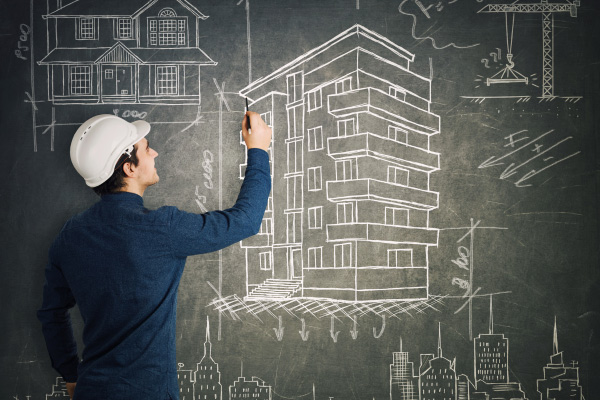Reading construction drawings is a key skill for contractors to have, as the drawings show what work is to be performed. This introduction to construction drawings will tell you what construction drawings are and describe the many types of drawings that are used in a construction project.
What are construction drawings?
Looking for a construction drawings definition? Construction drawings are used to represent the design, dimensions, materials, and methods required to build a project or perform construction work. They are similar to a detailed instruction manual telling contractors what work needs to be done, how to perform it, and the materials that are to be used.
A construction drawing is created by a member of the design team, an architect, engineer, or interior designer, usually. The drawings are often created using specialized software.
Drawings are particularly important in a construction project because they define the scope of work and are usually made part of the contract between the project owner and the general contractor.
What do construction drawings all have?
Construction drawings typically include various key components to communicate detailed information about a construction project. The specific contents may vary depending on the type and complexity of the project, but common elements found in construction drawings include:
- Title Block: Provides information such as the project title, drawing number, sheet number, scale, date, and the names of relevant parties like architects, engineers, and contractors.
- Site Plan: Illustrates the project’s location on the site, including property lines, existing structures, topography, and other site-specific details.
- Floor Plans: Show the layout of each floor of the building, indicating the arrangement of rooms, walls, doors, windows, and other key features.
- Elevations: Depict the exterior views of the building, showing its height and appearance from different perspectives.
- Sections: Cutaway views that reveal the interior structure of the building. These drawings may include cross-sections and details of specific building elements.
- Details: Provide close-up views and information about specific construction elements, such as connections, joints, and materials.
- Schedules: Lists of materials, finishes, and other components with relevant details and specifications.
- Specifications: A separate document or section that provides written descriptions and requirements for materials, construction methods, and quality standards.
- Legends:: Explanations of symbols, abbreviations, and other conventions used in the drawings.
- Notes: Additional written information that clarifies or supplements the graphical details in the drawings.
- Structural Drawings: Illustrations of the building’s structural elements, including foundations, beams, columns, and other load-bearing components.
- Mechanical, Electrical, and Plumbing (MEP) Drawings: Detail the layout and specifications for HVAC systems, electrical wiring, plumbing, and other building systems.
These components collectively provide a comprehensive set of instructions and information for contractors and construction teams to accurately and efficiently carry out the building project. The drawings are a crucial part of the construction documentation and are used throughout the entire construction process.
How are construction drawings made?
Rarely are construction plans drawn by hand anymore. They are either sketched and rendered using computer-aided drafting such as computer-aided design software. And in recent times, Building Information Modeling software has made it easy to render and visualize in detail the virtual construction models.
How to make construction drawings?
Construction drawings usually include a set of working drawings that cover different aspects of the project plan. These drawings usually comprise elevation drawings, floor plans, sections and detail drawings.
Types of construction drawings
There are many types of construction drawings, but they can generally be broken down into three categories: plans, shop drawings, and as-builts.
PlansPlans, also called blueprints or prints, are graphical representations of the work that needs to be completed during a project. They are called blueprints because the initial technology that allowed drawings to be replicated created a drawing with a blue background and white lines and typeface. These days most plans are sent electronically or plotted on a large format printer and are no longer blue.
There are several types of drawings that are used to show the work to be performed. They include floor/site plans, elevations, sections, details, and schedules. Each of these drawing types shows a different view of the building or site. Floor plans show a building or portion of a building from the sky, looking down. A construction site drawing or site plan shows the plot of land a project is on, detailing the position of the building and the site amenities, like curbs, sidewalks, and landscaping. Elevations look at the exterior or interior of the building and are used to show finishes like paint, stucco, siding, etc. Sections slice through the building vertically and show the structural elements. Details focus on a smaller area to provide more information, and schedules provide a list of the materials or equipment that are to be used on the project.
In a set of drawings, which is all the drawings for a specific project, there may be several disciplines represented. Those disciplines include architectural, structural, civil, landscape, mechanical, electrical, plumbing, and interior décor or furniture. Some or all of these disciplines may be included in a set of drawings, depending on the type of work required by the project.
Shop drawingsShop drawings are used to detail a specific installation or assembly, showing how it will be built. These drawings include information like dimensions, finishes, and material types or specifications. Instead of being produced by the design team, they are often created by manufacturers, suppliers, fabricators, or contractors. They may be created electronically, or hand drawn.
As-builtsAs-built drawings are created at the end of a project and show the work as it was actually constructed. During a project there are often changes made in the field, and those changes are documented on the as-builts for future reference. These drawings are important for future maintenance, repairs, and renovations, as they show the building or site conditions as they were actually built, not what was planned.
Construction drawings are a key tool in any project, as they tell contractors what work needs to be performed. Estimators use drawings to figure out how much a project will cost by quantifying the materials and labor needed to complete the work.
About PlanHub:
PlanHub is a leading provider of comprehensive bid management solutions for the construction industry. Our platform simplifies and streamlines the bidding process, connecting subcontractors and general contractors to facilitate collaboration and drive project success. With a commitment
to innovation and empowering our users, we continue to revolutionize the construction industry with cutting-edge features and a user-friendly experience.


